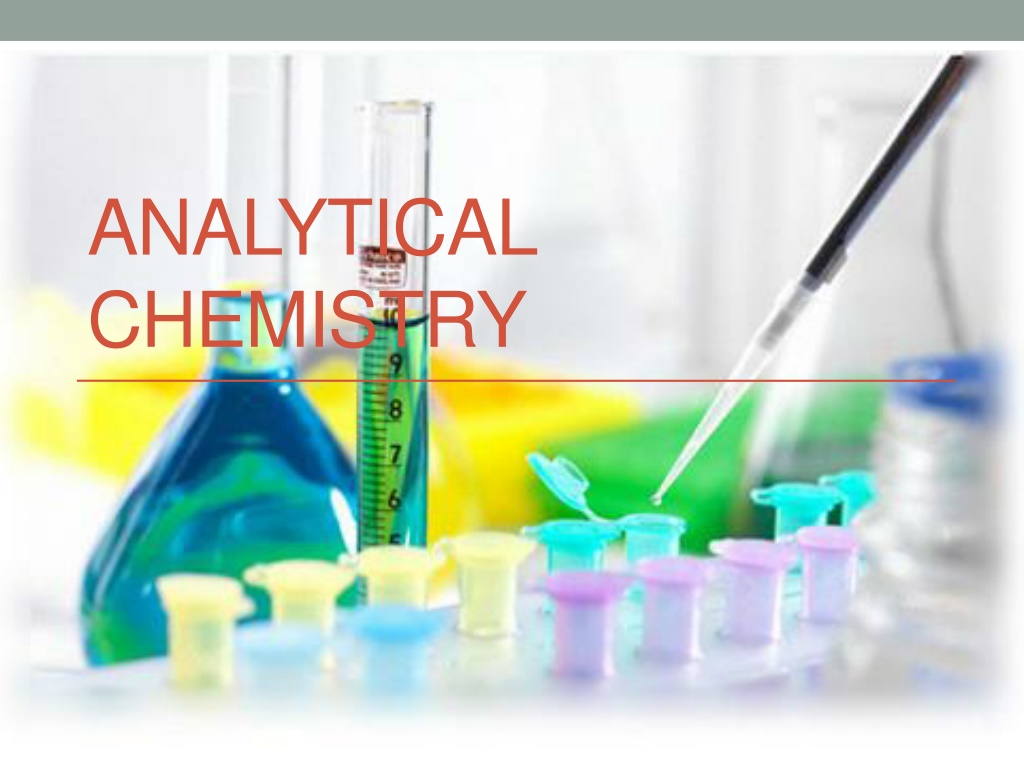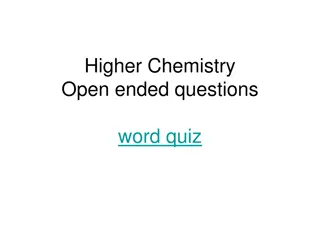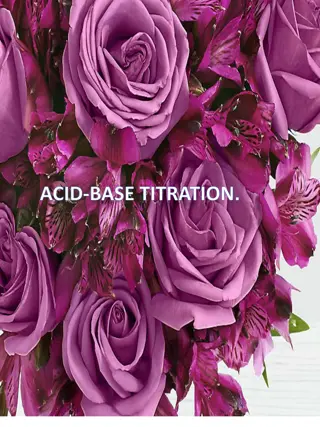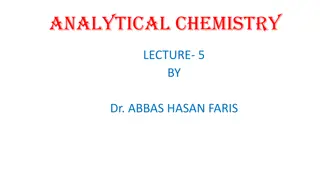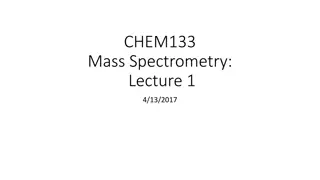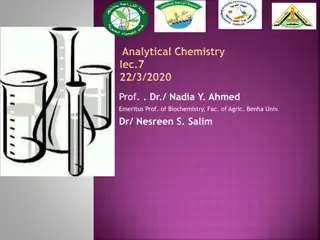Understanding Analytical Chemistry Concepts and Applications
In the realm of analytical chemistry, various methods are employed to detect acids and bases in solutions. Litmus, a natural dye, is commonly utilized for this purpose, turning red in acidic conditions and blue in basic conditions. The slides presented touch upon key concepts such as the Arrhenius definition, conjugate acids and bases, acid dissociation, and buffer solutions. Additionally, the Hasselbalch equation is highlighted as a crucial derivation in the context of acid dissociation constants, providing insights into maintaining pH stability in chemical systems.
Download Presentation

Please find below an Image/Link to download the presentation.
The content on the website is provided AS IS for your information and personal use only. It may not be sold, licensed, or shared on other websites without obtaining consent from the author. Download presentation by click this link. If you encounter any issues during the download, it is possible that the publisher has removed the file from their server.
E N D
Presentation Transcript
ANALYTICAL CHEMISTRY
pH In the laboratory, we can detect acids and bases in solution in several ways. Perhaps uses a substance called litmus, a natural dye derived from lichen. It turns red in acidic conditions and blue in basic conditions the simplest test
Conjugate acid base Conjugate acid ion that forms when one H ion is added to a molecule or ion. ion is removed from Conjugate base ion that forms when one H a molecule or ion lost. the molecule or the molecule or
Buffer solution : A buffer solution is an aqueous solution consisting of a mixture of a weak acid and its conjugate base or a weak base and its conjugate acid. It has the property that the pH of the solution changes very little when a small amount of strong acid or base is added to it. Buffer solutions are used as a means of keeping pH at a nearly constant value in a wide variety of chemical applications
Hasselbalch equation is derived from the acid dissociation constant equation by the following steps : The Henderson
Acid base balance in blood Buffer solutions are necessary to keep the correct pH for enzymes in many organisms to work. Many enzymes work only under very precise conditions; if the pH strays too far out of the margin, the enzymes slow or stop working and can denature, thus permanently disabling their catalytic activity. A buffer of carbonic acid (H2CO3) (HCO3 ) is present in blood plasma, to maintain a pH between 7.35 and 7.45. and bicarbonate
Carbonic acid is formed by dissolving carbon dioxide in body fluids as in equation bellow: Normally, in body fluids such as blood , their is 24 meq/L of bicarbonate ion to 1.2 meq/L of carbonic acid. The pH of blood is within 7.35-7.45. [HCO3-]/ [H2CO3] 20/1 normal pH 7.35-7.45 [HCO3-]/ [H2CO3] 15/1 acidemia pH less than7.35 [HCO3-]/ [H2CO3] 25/1 alkalemia pH more than 7.45
Carbonic acid is an intermediate step in the transport of CO2out of the body via respiratory gas exchange. The hydration reaction of CO2is generally very slow in the absence of a catalyst, but red blood cells contain carbonic anhydrase, which both increases the reaction rate and dissociates a hydrogen ion (H+) from the resulting carbonic acid, leaving dissolved in the blood plasma. This catalysed reaction is reversed in the lungs, where it converts the bicarbonate back into CO2and allows it to be expelled. This equilibration plays an important role as a buffer in mammalian blood Dialysis in living system bicarbonate (HCO3-)
Electrolyte and non-electrolyte solutions: Aqueous solutions either conduct electricity or they not , if they conduct electricity are called electrolytic solution if the not are called non electrolytic solution . Aqueous solution : The solution in living systems are aqueous solution , that is are made with water. Solubility : The amount of solute that dissolves in a given quantity. Solute are more soluble in hot than cold solvents .
Solubility is defined as amount of solute that dissolves in given quantity of solvent to form saturated solution. The solubility depends on a number of factors, such as solvent, pressure on solvent, and temperature. Completely miscible: two liquids that are infinitely soluble in each other's such as ethanol in water. Partially miscible: when two solvent partially dissolved in each other. Immiscible: liquids are insoluble in each other such as gasoline in water.
Intramolecular molecules cases several hindered to several thousands of them to cluster together. The size of these clustered ranges from 1-100 containing particle of this size is called colloids. A uniform dispersion of a colloid in water is called colloidal dispersion (cloudy) attraction between nm. Matter
Dispersed substance Example Liquid gas fog, clouds Solid-gas Smoke Gas liquid foams, whipped cream Liquid-liquid Milk, butter Solid-liquid Paint , glue Solid-solid Colored glass
Dialysis Dialysis in living Kidney are an example of organ in body that use dialysis to maintain the solute and electrolyte balance of the blood. In 68 kg adult 180 liter of blood purified to about 99.0 % and 1% remaining.
Dialysis works on the principles of the diffusion of solutes and ultrafiltration of fluid across a semi- permeable membrane. Diffusion describes a property of substances in water. Substances in water tend to move from an area of high concentration to an area of low concentration. Blood flows by one side of a semi- permeable membrane, and a dialysate, or special dialysis fluid, flows by the opposite side. A semipermeable membrane is a thin layer of material that contains various sized holes, or pores. Smaller solutes and fluid pass through the membrane, but the membrane blocks the passage of larger substances (for example, red blood cells, large proteins).
Examples of terms describing relative osmotic pressure of two solutions Isotonic A 1 M glucose and 1 M urea (non-electrolyte) the solutions are isotonic Hypertonic A 1 M NaCl solution has a higher osmotic pressure than 1 M glucose. Therefore, its hypertonic compared to 1 M glucose solution. Hypotonic A 1 M NaCl solution has lower osmotic pressure than a 2 M LiBr solution. Therefore, its hypotonic compared to 2M LiBr solution.
Crenation in red blood cells. Red blood cells when placed in saline (NaCl), the solution inside the cell is hypotonic compared to the saline solution and direction , water leave the RBCs to solution that lead to shrink . process is called crenation. osmosis reverse this
Hemolysis: when red blood cell placed in water. The solution inside the cell is hypertonic compared to pure water, so water enter the cell , so much water enters that the cell ruptured. The rupture red cell is called hemolysis. hemolyzed. Crenation: when red cell placed in concentrated saline (sodium fluoride) solution. The solution compared to saline solution and osmosis occurs in reverse direction. Water leaves the cell and passes to solution. This causes the red blood cell to shrivel and shrink. We say that cells inside cell is hypotonic Note: A solution inside blood cells the red blood cell neither crenation nor hemolysis. 0.95% saline solution is isotonic compared to the
Ions in living system Inorganic ions in animals and plants are ions necessary for vital cellular activity. In body tissues, ions are also known as electrolytes, essential for the electrical activity needed to support muscle contractions and neuron activation. They pressure of body fluids as well as performing a number of other important functions. Below is a list of some of the most important ions for living things as well as examples of their functions: contribute to osmotic
Ca2+ calcium is a component of bones and teeth. It also functions as a biological messenger, as do most of the ions listed below. See hypocalcaemia K+ potassium ions' main function in animals is osmotic balance, particularly See hypokalemia. Na+ sodium ions have a similar role to potassium ions. See sodium deficiency. Mg2+. Most importantly, magnesium ions are a component of chlorophyll. See magnesium deficiency Cl . Inability to transport chloride ions in humans manifests itself as cystic fibrosis (CP) in the kidneys.
PO43, adenosine triphosphate (ATP) is a common molecule which stores energy in form. Bone is calcium phosphate. Fe2+/Fe3+ hemoglobin, the main oxygen carrying central iron ion. NO3 , source of nitrogen in plants for the synthesis of proteins. an accessible molecule has a
Pollution Pollution, also called environmental pollution, the addition of any substance (solid, liquid, or gas) or any form of energy (such as heat, sound, or radioactivity) to the environment at a rate faster than it can be dispersed, diluted, decomposed, recycled, or stored in some harmless form. The major kinds of pollution are (classified by environment) pollution, and land pollution. Modern society is also concerned about specific types of pollutants, such as noise pollution, light pollution, and even plastic pollution. air pollution, water
